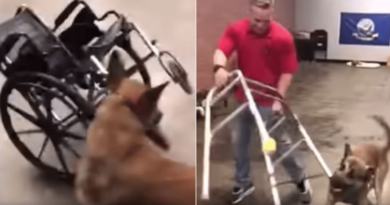Movement Aims to Make Veterinary Care More Affordable
When Tara, a black Labrador retriever-rottweiler mix, needed surgery on both knees, her owner consulted nearby private practice veterinarians. To her dismay, estimates to reconstruct the dog’s knees — which had torn cruciate ligaments and meniscuses — came in between $10,000 and $20,000.
“I don’t have that kind of money,” the owner, Danielle Correnti, told the VIN News Service. “I’m a single mother of two.”
Tara could not walk, and the quality of her life was deteriorating. Correnti didn’t know where to go.
Then she learned from a friend about a nonprofit clinic called Angell at Nashoba. Located in Westford, Massachusetts, the clinic is nearly an hour’s drive from Correnti’s home. It was farther than Correnti would have wanted to go, but for eligible pet owners, veterinary care there is available for a discount.
GET THE BARK IN YOUR INBOX!
Sign up for our newsletter and stay in the know.
Correnti lives in public housing and receives food stamps, which qualified her for reduced-cost care. For the two surgeries for Tara — performed in July and October 2019 — she was charged $1,500.
The charitable clinic saved her dog’s life, Correnti said: “If I didn’t find them, I would have had to put Tara down.”
Established in 2016, Angell at Nashoba is one manifestation of a growing movement to make veterinary care more accessible to pet owners who cannot afford standard private practice rates. Angell at Nashoba and clinics like it use community donations and grants to provide subsidized care to low-income clients on public assistance.
Providing some level of charitable care is nothing new in the profession. Individually, veterinarians in private practice long have used their discretion to help some clients in difficult financial circumstances. But a formal movement advocating access to care for every pet owner, regardless of ability to pay, is a recent development. The philosophy is not uniformly embraced, as there remain practitioners who believe that people who cannot afford veterinary care for pets should not keep pets. Many in private practice also view nonprofit and low-cost clinics as unfair competition if their clients aren’t required to show proof of income.
Assessing the need
The access movement gained momentum with the founding in 2016 of the Access to Veterinary Care Coalition (AVCC). The organization grew out of the Program for Pet Health Equity at the University of Tennessee, Knoxville, College of Social Work. That college, working with the UTK College of Veterinary Medicine, has advanced and given a formal name to the field of veterinary social work, which focuses on the bonds between humans and other animals, the healing power of animal companionship in human life, and emotional support for veterinary professionals.
The AVCC solidified relationships among organizations in the access-to-veterinary-care realm. Its members include people working in nonprofit and for-profit care alike. At a first-ever Access to Veterinary Care Symposium in 2019, the organization drew more than 100 attendees from across the U.S. and Canada, according to a news report in the Journal of the American Veterinary Medical Association.
One of the the AVCC’s first projects was a study assessing barriers to veterinary care encountered by pet owners across the socioeconomic spectrum. The study found that nearly 28% of pet owners had recently experienced a barrier to veterinary care, overwhelmingly because of financial reasons. That proportion may be rising due to economic stress caused by the COVID-19 pandemic, according to a June 10 JAVMA news article.
‘We’re going to do a better job’
The AVCC is chaired by Dr. Michael Blackwell, director of the Program for Pet Health Equity. With long experience in public health, Blackwell formerly served as chief of staff in the office of the Surgeon General of the U.S. and chief veterinary officer of the U.S. Public Health Service. He is also a former dean at the University of Tennessee College of Veterinary Medicine.
Blackwell said his interest in improving access to care arose when he became involved with a shelter in Knoxville, the Young-Williams Animal Center. He chaired the center’s board for five years starting in 2005, and served as administrator in 2011-12. “My time at the shelter helped me to see that there are many bonded families that cannot afford private veterinary care. Yet they deserve companionship with pets, especially given the benefits humans derive from these relationships,” he said.
A centerpiece of the Program for Pet Health Equity is a project called AlignCare, described as a “One Health healthcare system that aligns the current resources of social service agencies and veterinary service providers” with funding from donations. One Health is the concept that the well-being of people, other animals and the environment are intertwined.
The program allots funds to participating veterinary clinics, enabling the clinics to provide subsidized care to pets belonging to people on public assistance. Veterinary social workers help eligible pet owners enroll.
Still in pilot form, the program started in 2019 with six practices in North Carolina, Tennessee, Arizona and New York. It expanded in July to Nevada. Today, there are three sites in Las Vegas and one in Reno, and more pending in both cities.
AlignCare partners with both nonprofit and for-profit clinics because its leaders believe that meaningful access calls for participation from the whole community.
“We’re not out here saying, ‘Well, we need more nonprofits to step up,’ ” Blackwell said. “Now, we do need nonprofits if they’re going to be in a community that a for-profit practice can’t survive in. But in the end, we need all stakeholders … to start working in new ways with that outcome in mind, that we’re going to do a better job of reaching these families.”
Blackwell said AlignCare has drawn $4 million in funding in its first three years. One well-known, influential supporter is Maddie’s Fund, a nonprofit foundation active in shelter medicine and pet foster care realms, which provided $2.8 million in startup money, according to a JAVMA news article.
Mary Ippoliti-Smith, a member of Maddie’s Fund’s executive leadership team, said the partnership between social services and veterinary services helps demonstrate “what’s happening at both ends of the leash.” The organization’s interest in access to care stems from witnessing animals being surrendered to shelters by owners unable to afford veterinary attention for the animals.
One way that AlignCare providers offer more affordable care is by practicing “incremental care.” Blackwell explained that this approach, also known as “tiered care,” is not novel. Practitioners historically have offered incremental care to keep costs down for owners who can’t afford expensive procedures or tests.
He gave an example of dog brought to a veterinarian for vomiting. The gold standard of care would involve a blood test, an X-ray to determine if the dog swallowed a foreign object, and possibly ultrasound imaging to probe further. The incremental-care approach would be to provide a drug to quell nausea while having the owner carefully monitor the dog to determine whether more active treatment is needed or the problem resolves on its own in time.
How the program works
Kelly Self is hospital manager at Central Veterinary Hospital in Knoxville, Tennessee, an AlignCare affiliate. Self said the hospital has worked in the past with other grant programs that assist low-income clients but AlignCare is by far the easiest to work with.
AlignCare takes care of means-testing pet owners to determine their eligibility for assistance before sending them to the hospital. If pet owners with limited resources call the hospital directly, staff can direct them to AlignCare.
And that, Self said, is gratifying. “We don’t necessarily have to turn people away because they don’t have the money,” she said. “We have an option for them. It also helps clients who wouldn’t normally be able to [afford] care for their pet.”
AlignCare clients are responsible for 20% of their bill; the organization covers the remainder.
Self called the program a “wonderful resource,” but noted that participating brings challenges. “Our new AlignCare clients have had limited access to veterinary care for years, and sometimes must be walked through difficult necessary decisions that require the assistance of their social worker in coordination with the veterinarian,” she said, “such as necessity of amputation or end-of-life decision, which can be very time-consuming and intense.”
Three-month wait for appointments
Separately, a mini movement in affordable veterinary care is underway in Massachusetts, home to the community clinic Angell at Nashoba. The clinic is modeled after Tufts at Tech, a nonprofit jointly established in 2012 by the veterinary school at Tufts University and Worcester Technical High School. Tufts at Tech combines care for pets from households with limited financial means with training for veterinary students in community care and experience for high school students in clinical care and practice management.
Tufts at Tech has inspired at least three similar programs: Two — Angell at Nashoba and Angell at Essex — are partnerships of the Massachusetts Society for the Prevention of Cruelty to Animals-Angell Animal Medical Center with area high schools. A third is Monty Tech Veterinary Clinic at Montachusetts Regional Vocational Technical School.
Angell at Nashoba’s director, Dr. Laurence Sawyer, said that in its first year, the clinic saw 700 cases, with a one-month wait for appointments.
Dr. Laurence Sawyer, director of Angell at Nashoba, a nonprofit clinic in Massachusetts, performs an abdominal ultrasound on a cat named Tigger.
Today, the clinic sees about 3,000 cases per year, she said, and the wait for appointments has stretched to three months.
“We can’t keep up,” Sawyer said. “It’s just, there’s so much need out there, and there’s not enough places that have accessible care and affordable care.”
Formerly a private practitioner, Sawyer said she had been interested for a long time in nonprofit work, volunteer work and teaching. When Tufts at Tech opened, Sawyer volunteered at the clinic on her days off, mostly helping fourth-year veterinary students with surgical cases. When the job arose at Angell at Nashoba “to combine teaching, nonprofit work and helping underserved people and pets,” she said, “I realized it was the perfect fit.”
Is a pet a luxury?
Enthusiasm for nonprofit and charitable veterinary work is not universal within the profession. Dr. Jeff Redman counts himself among those with what he calls “old school” views about pet ownership.
“[A]n animal is a luxury, not a necessity, with the exception of a few true service dogs. … ” he said. “[W]e’re supposed to be advocates for the animals.” By enabling people to keep animals whose care they cannot afford, he elaborated, “I’m not sure that we’re really advocating for the animals. And we’re certainly not advocating for our own industry, our own profession, because we’re saying our services aren’t worth that much. You know, ‘Go here, it’s cheaper … The service we provide here is overpriced.’ “
Redman also is troubled that nonprofit or otherwise low-cost practices don’t necessarily require proof of income eligibility before providing discounted services. The owner of a small animal practice in Ellijay, Georgia, Redman said there are three low-cost clinics in his area supported by grants and donations. Two of the clinics provide services at standard prices, as well as lower prices for low-income clients.
Redman said he’s witnessed his own clients, whom he believes are able to afford market prices, choose to have pets neutered at a low-cost clinic. While such clinics may provide the surgery for a lower price, he said he suspects they may not provide the same level of care, monitoring and patient support as a standard private practice.
Dr. Ted Cohn, a former president of the American Veterinary Medical Association and a former practice owner who belongs to the AVCC, said he at one time shared the concern about unfair competition. He sees it differently now.
“The vast majority of [low-income] people don’t go to private practitioners because they can’t afford it,” Cohn said. “And there may be a little bit of competition there — I don’t doubt it … but I think by and large, it’s a fallacy. They’re not really direct competitors, and it’s time that we all started to work together to solve these problems.”
Dr. Sheila Segurson, director of research for Maddie’s Fund, said income is not a proxy for quality of pet ownership. “My pet doesn’t care what my salary is,” she said. “My pet doesn’t really even care if I have a home. They care about me providing them with love and being around them, and that’s not related to income at all.”
Recognizing a range of barriers to access
Cohn pointed out that barriers to veterinary care extend beyond financial means. “There’s cultural barriers, there’s language barriers, there’s transportation barriers,” he said.
In the United States, nine out of 10 veterinarians are white. Existing cultural and language barriers could be overcome by diversifying the profession, Cohn said: “Becoming a more diverse profession … would give us a little broader understanding, a little broader acceptance.”
Segurson said diversity has always been a part of the access-to-care movement but interest in the aspect is growing.
Echoing Cohn, she said, “A big piece of it is increasing the diversity from within. … [I]f I want the people who have a different color of skin or different viewpoints than I have to be able to come to my clinic, I want to make that clinic welcoming. And I can make that clinic welcoming by having more diversity among my own employees.”
Broadening access is good not only for pet owners but for the profession, she added: “One way that we can increase demand for veterinary services is expanding our vision and thoughts about who those services are going to be provided to.”
In a world grappling with many social justice issues related to privilege and lack of access, Blackwell said, “This is veterinary medicine’s social justice issue. We didn’t cause it, but it has fallen squarely onto our laps.”





doxycycline generic buy doxycycline for dogs odering doxycycline
darknet marketplace https://worlddarkwebdrugstore.com/ tor dark web
dark web site https://kingdomdarkwebmarket.com/ dark market